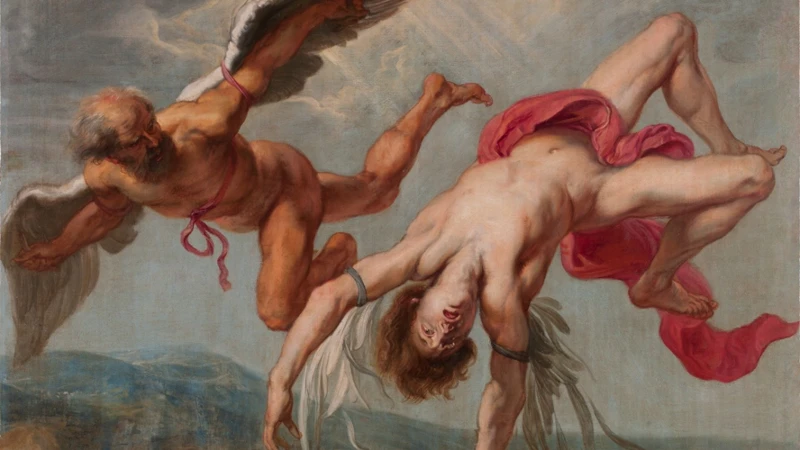Imagine a world where humans possess the power of flight, soaring through the skies with the grace and freedom of birds. This seemingly impossible fantasy became a reality in the ancient Greek myth of Icarus and Daedalus. This tale captivates audiences with its cautionary tale of ambition and hubris, warning against the dangers of reaching too high. In this article, we delve deep into the mythical origins of Icarus and Daedalus, exploring their incredible escape plan from the treacherous labyrinth, the tragic flight that led to Icarus’ demise, and the symbolism and moral lessons embedded within this timeless story. Join us as we unravel the enthralling legend of Icarus and Daedalus, where triumph and tragedy exist in equal measure.
Contents
- The Tale of Icarus and Daedalus
- The Labyrinth and the Escape Plan
- Flying Too Close to the Sun
- The Symbolism and Morality of the Myth
- Conclusion
-
Frequently Asked Questions
- 1. What is the moral of the story of Icarus and Daedalus?
- 2. Why did Daedalus create wings for himself and Icarus?
- 3. What happened to Icarus when he flew too close to the sun?
- 4. What does the labyrinth symbolize in the myth?
- 5. Was Daedalus a god or a mortal?
- 6. Are there any other myths involving Daedalus?
- 7. What are some contemporary references to the myth of Icarus and Daedalus?
- 8. Are there any lessons we can apply from this myth to modern life?
- 9. How does the myth of Icarus and Daedalus relate to the concept of hubris?
- 10. Is the story of Icarus and Daedalus based on any historical events?
- References
-
Frequently Asked Questions
- 1. Can you provide a brief summary of the myth of Icarus and Daedalus?
- 2. How did Daedalus build the labyrinth?
- 3. How did Daedalus create the wings used by him and Icarus?
- 4. What happened during Icarus and Daedalus’ flight?
- 5. What were the consequences of Icarus flying too close to the sun?
- 6. How is the myth of Icarus and Daedalus symbolic?
- 7. What moral lesson can we learn from this myth?
- 8. What is the significance of flying too close to the sun?
- 9. How does the myth of Icarus and Daedalus still resonate today?
- 10. Are there any famous artistic representations of the myth?
- References
- Read More
The Tale of Icarus and Daedalus

The tale of Icarus and Daedalus is a captivating myth that has been passed down through generations. It revolves around the skilled craftsman Daedalus and his ambitious son Icarus. The story takes place during the time when King Minos ruled over Crete. Daedalus, known for his ingenuity, was called upon by the king to construct an impenetrable labyrinth to house the ferocious half-human, half-bull creature known as the Minotaur. This labyrinth was an architectural marvel, designed to confuse and trap anyone who dared to enter it. However, Daedalus and Icarus found themselves trapped inside the labyrinth they had created. As they searched for a way to escape, Daedalus came up with a brilliant plan – they would fashion wings made of feathers and wax. Daedalus meticulously crafted the wings, attaching feathers with string and sealing the connection with beeswax. He taught Icarus how to wear the wings and warned him to neither fly too high nor too low, as both extremes would bring about danger. This tale, fraught with suspense and intrigue, sets the stage for the tragic events that unfold as Icarus and Daedalus attempt their daring escape. For more fascinating insights into the world of Greek mythology and legends, check out our article on ancient Greek gods, goddesses, tales, and legends.
The Labyrinth and the Escape Plan

The labyrinth, a mysterious and treacherous maze, became the stage for Daedalus and Icarus’ daring escape plan. Daedalus, driven by his ingenuity, constructed the intricate labyrinth to contain the terrifying Minotaur. This architectural marvel was designed with a network of winding corridors and dead ends, confounding anyone who entered. However, fate soon trapped Daedalus and his son Icarus within the very labyrinth they had built. Determined to find a way out, Daedalus hatched a daring plan. He crafted wings using feathers and beeswax, teaching Icarus how to wear them. The wings were a symbol of freedom, offering the possibility of flight. As they prepared to take flight, Daedalus cautioned Icarus not to fly too close to the sun, for fear that the wax would melt. This story of escape and adventure serves as a cautionary tale, reminding us of the consequences of both ambition and disobedience. To discover more about the significance of zodiac signs in astrology, and their influence in ancient Greece, delve into our insightful article on the subject.
Building the Labyrinth
Building the labyrinth was a monumental task that showcased Daedalus’ exceptional architectural skills. The intricate design of this immense structure aimed to confound and trap anyone who ventured inside. Daedalus employed his ingenuity and creativity to construct a complex maze with winding corridors, dead ends, and numerous twists and turns. This labyrinth, located beneath the royal palace of King Minos in Crete, became a symbol of power and dominance. Its construction required a meticulous approach, with Daedalus carefully planning the layout and ensuring it remained hidden from prying eyes. To create a sense of disorientation and confusion, doors were strategically placed to trick those inside into going in circles. The labyrinth’s overall structure was a masterpiece of engineering, showcasing Daedalus’ brilliance and attention to detail. To learn more about the significance of zodiac signs and astrology, visit our article on the significance of zodiac signs and astrology.
The Creation of Wings
The creation of the wings in the tale of Icarus and Daedalus is a testament to the ingenious craftsmanship of Daedalus. Facing imminent danger and determined to escape the labyrinth, Daedalus devised a plan to fashion wings that would enable himself and his son to fly to freedom. Using materials found within the labyrinth, Daedalus carefully selected a variety of sturdy feathers. He strategically arranged the feathers, attaching them to a framework made of string. To ensure the feathers remained securely in place, Daedalus sealed the connections with fragrant beeswax. This meticulous construction allowed for flexibility in flight, as the wings would move and adjust with the wearer’s motions. Daedalus imparted his knowledge to Icarus, instructing him on the proper way to fasten and wear the wings. With each feather a testament to their artistry, the wings embodied the hope, ambition, and desire for liberation that burned within both father and son. The creation of the wings showcases the resourcefulness and skill of Daedalus, setting the stage for the daring flight that awaited them.
Flying Too Close to the Sun

The pivotal moment of the tale of Icarus and Daedalus is when Icarus, consumed by his youthful exuberance, disregards his father’s warnings and flies too close to the sun. The siren call of the boundless sky lures Icarus higher and higher, until the wax holding his feathered wings begins to melt. As the wax melts away, the feathers loosen, and Icarus plummets uncontrollably towards the unforgiving sea below. This cautionary tale serves as a timeless reminder of the dangers of overstepping limits and succumbing to pride and recklessness. Like Icarus, who paid the ultimate price for his hubris, it serves as a cautionary reminder for all of us to remain grounded and mindful of our own limitations. The tragic consequences of Icarus’ flight too close to the sun stand as a powerful metaphor for the inevitable consequences that often befall those who dare to challenge the boundaries set by nature and fate.
The Tragic Flight
The tragic flight of Icarus is the climactic moment in the myth of Icarus and Daedalus, serving as a cautionary tale about the perils of hubris. As Daedalus and Icarus prepared to make their daring escape from the labyrinth, Daedalus warned his son not to fly too close to the sun, as the heat could melt the wax holding their wings together. However, consumed by the exhilaration of flight, Icarus disregarded his father’s warning. As he soared higher and higher, the warmth of the sun lured him even closer. The wax began to soften and weaken, causing the feathers to come loose. Panic set in as Icarus desperately flapped his wings, but it was too late. The feathers detached one by one, leaving Icarus plummeting down towards the sea. The once magnificent flyer met his tragic demise in the depths of the Aegean Sea, forever serving as a somber reminder of the consequences of reckless ambition. The story of Icarus’ ill-fated flight is a poignant reminder that even the greatest feats can be undone by a single moment of arrogance.
The Consequences
The consequences of Icarus flying too close to the sun were dire. As he soared through the sky, feeling the exhilaration of his newfound freedom, Icarus became consumed by the sheer joy of flight. Ignoring his father’s warning, he couldn’t resist the temptation to ascend higher and higher. Ignorant of the consequences, Icarus flew too close to the scorching sun. The heat from the sun’s rays melted the wax that held the feathers together, causing them to come loose. Helplessly, Icarus tumbled towards the unforgiving sea below. The sea, forever marred by this tragedy, came to be known as the Icarian Sea. The sight of his son plummeting to his death filled Daedalus with immense grief and sorrow. He had lost his beloved child due to the reckless pursuit of unlimited freedom. The consequences of Icarus’s actions serve as a powerful reminder of the dangers of hubris and the need to heed the wisdom of those who came before us.
The Symbolism and Morality of the Myth

The myth of Icarus and Daedalus holds a rich symbolism that imparts valuable moral lessons. The story serves as a cautionary tale, warning against the perils of hubris and the consequences of exceeding our limits. Icarus, consumed by the newfound power of flight, disregards his father’s advice and flies too close to the sun. This symbolizes the dangers of reckless ambition and the consequences that arise from overreaching. The sun, representing divine power and authority, signifies the boundaries set by the gods. Icarus, driven by his own desire to surpass these boundaries, meets his tragic end. This serves as a reminder that we must recognize and respect our limitations. The wax on Icarus’ wings, which ultimately melts due to the sun’s heat, symbolizes the fragility of human ambition and emphasizes the importance of balance and temperance. The myth also highlights the profound bond between a father and son, showcasing the parental wisdom imparted to younger generations. By heeding the wisdom and guidance of our elders, we can navigate life’s challenges with prudence and avoid catastrophic outcomes. Through its symbolism and moral teachings, the myth of Icarus and Daedalus invites introspection and reflection, urging us to find harmony between ambition and humility.
Conclusion

In conclusion, the myth of Icarus and Daedalus serves as a timeless reminder of the perils of unchecked ambition and overreach. It highlights the consequences of ignoring warnings and succumbing to hubris. The tale reminds us that while seeking and striving for greatness is admirable, it must be tempered with wisdom and caution. Icarus, in his youthful exuberance, let his excitement get the better of him, ultimately leading to his tragic demise. However, the story also showcases the brilliance and resourcefulness of Daedalus, who was able to overcome obstacles and devise a groundbreaking escape plan. The symbolism within the myth runs deep, reminding us that our actions have consequences and that we should strive for balance and moderation in all endeavors. As we reflect on the myth of Icarus and Daedalus, let us learn from their mistakes and strive to find our own middle ground between ambition and humility.
Frequently Asked Questions

1. What is the moral of the story of Icarus and Daedalus?
The moral of the story is to heed the warnings of those wiser than us and to avoid excessive pride and ambition. It serves as a poignant reminder of the consequences of flying too close to the sun.
2. Why did Daedalus create wings for himself and Icarus?
Daedalus created wings as a means of escape from the labyrinth they were trapped in. He used his inventiveness to fashion wings from feathers and wax, allowing them to fly away to freedom.
3. What happened to Icarus when he flew too close to the sun?
When Icarus flew too close to the sun, the heat melted the wax holding his wings together, causing them to fall apart. He lost control and plummeted into the sea, meeting a tragic end.
4. What does the labyrinth symbolize in the myth?
The labyrinth symbolizes the complexities and challenges of life. It represents the obstacles we face and the need for ingenuity and creativity to overcome them.
5. Was Daedalus a god or a mortal?
Daedalus was a mortal, but he possessed extraordinary skills and intellect. He was considered one of the greatest inventors and craftsmen of his time.
6. Are there any other myths involving Daedalus?
Yes, Daedalus appears in various other Greek myths. One notable story is his involvement in the escape of Theseus from the labyrinth and his role in the creation of Talos, the bronze giant.
7. What are some contemporary references to the myth of Icarus and Daedalus?
The myth of Icarus and Daedalus has inspired many artists, writers, and filmmakers over the years. It has been referenced in literature like James Joyce’s “A Portrait of the Artist as a Young Man” and depicted in paintings by artists such as Bruegel and Matisse.
8. Are there any lessons we can apply from this myth to modern life?
Absolutely. The myth encourages us to find a balance between ambition and caution. It reminds us to listen to wise counsel and be mindful of the potential consequences of our actions.
9. How does the myth of Icarus and Daedalus relate to the concept of hubris?
The myth serves as a cautionary tale about the dangers of hubris, or excessive pride. Icarus’ arrogance and disregard for his father’s warnings lead to his tragic downfall.
10. Is the story of Icarus and Daedalus based on any historical events?
While it is difficult to determine the historical accuracy of mythical stories, the tale of Icarus and Daedalus is believed to be a work of fiction created to convey moral lessons and explore the human condition.
References
Frequently Asked Questions

1. Can you provide a brief summary of the myth of Icarus and Daedalus?
The myth of Icarus and Daedalus is a cautionary tale from Greek mythology. It tells the story of a skilled inventor named Daedalus and his son Icarus, who attempt to escape from imprisonment.
2. How did Daedalus build the labyrinth?
According to the myth, Daedalus constructed the labyrinth for King Minos of Crete. The labyrinth was an intricate maze designed to imprison the terrifying Minotaur, a half-human, half-bull monster.
3. How did Daedalus create the wings used by him and Icarus?
In a stroke of genius, Daedalus used feathers and wax to construct the wings. He carefully crafted them by attaching feathers to a wooden frame and securing them with wax and string.
4. What happened during Icarus and Daedalus’ flight?
Excited by the freedom of flight, Icarus became overconfident and flew too close to the sun. The heat melted the wax holding his wings together, causing them to fall apart. Icarus plunged into the sea and drowned.
5. What were the consequences of Icarus flying too close to the sun?
Icarus’ hubris cost him his life. His attempt to reach greater heights led to his downfall, serving as a tragic reminder of the dangers of arrogance and disobedience.
6. How is the myth of Icarus and Daedalus symbolic?
The myth symbolizes the human desire for freedom, the consequences of hubris, and the limitations of mortal beings. It serves as a cautionary tale, warning individuals against letting their ambitions blind them to their own limitations.
7. What moral lesson can we learn from this myth?
The myth teaches us the importance of humility, self-control, and the acceptance of our own limitations. It warns against recklessness and reminds us to be mindful of the consequences of our actions.
8. What is the significance of flying too close to the sun?
Flying too close to the sun symbolizes the dangers of ambition without caution. It represents the reckless pursuit of glory or success without considering the potential risks and consequences.
9. How does the myth of Icarus and Daedalus still resonate today?
The myth continues to resonate in modern times as a reminder to individuals and societies about the perils of overreaching and ignoring the boundaries set by nature or society. It serves as a timeless cautionary tale.
10. Are there any famous artistic representations of the myth?
Yes, the myth of Icarus and Daedalus has been depicted in various works of art throughout history. One of the most famous depictions is the painting “The Fall of Icarus” by Pieter Bruegel the Elder, which captures the tragic moment of Icarus’ downfall.
References
- What god did Icarus offend by flying too close to the Sun?
- What does it mean to say “he flew too close to the sun”?







